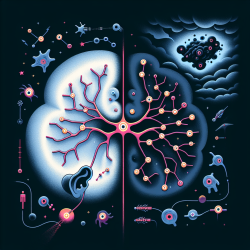Introduction
The role of astrocytes in the brain has long been underestimated, often overshadowed by the more prominent neurons. However, recent research, particularly the study titled Neuroprotective activation of astrocytes by methylmercury exposure in the inferior colliculus, has shed light on the crucial protective functions astrocytes perform, especially in the context of auditory dysfunction induced by methylmercury (MeHg) exposure.
The Study: A Closer Look
The research conducted by Ishihara et al. (2019) explored the effects of MeHg on the inferior colliculus (IC), a vital component of the auditory pathway. The study revealed that MeHg exposure leads to increased latency and decreased threshold in auditory brainstem responses, indicative of auditory dysfunction. Interestingly, this dysfunction was accompanied by astrogliosis, an increase in astrocytic activity, suggesting a protective response against MeHg-induced neuronal damage.
Astrocytes: The Unsung Heroes
Astrocytes, the star-shaped glial cells in the brain, have been shown to play a neuroprotective role by upregulating brain-derived neurotrophic factor (BDNF) in response to MeHg exposure. This adaptive response helps mitigate the neurotoxic effects of MeHg, potentially offering a new avenue for therapeutic interventions in auditory disorders.
Implications for Practitioners
For speech-language pathologists and other practitioners working with children experiencing auditory disorders, understanding the protective role of astrocytes can inform treatment strategies. Here are some practical applications:
- Therapeutic Interventions: Consider therapies that support astrocytic health and function, potentially enhancing the natural protective mechanisms against auditory dysfunction.
- Further Research: Encourage continued research into astrocytic functions and their implications for auditory health, as this could lead to innovative treatments for auditory processing disorders.
- Holistic Approaches: Integrate knowledge of neuroprotective mechanisms into holistic treatment plans that address both neuronal and glial health.
Encouraging Further Exploration
The findings from this study underscore the importance of astrocytes in neuroprotection and highlight the need for further research into their roles in the auditory system. Practitioners are encouraged to delve deeper into the literature and explore how these insights can be translated into clinical practice.
To read the original research paper, please follow this link: Neuroprotective activation of astrocytes by methylmercury exposure in the inferior colliculus.










